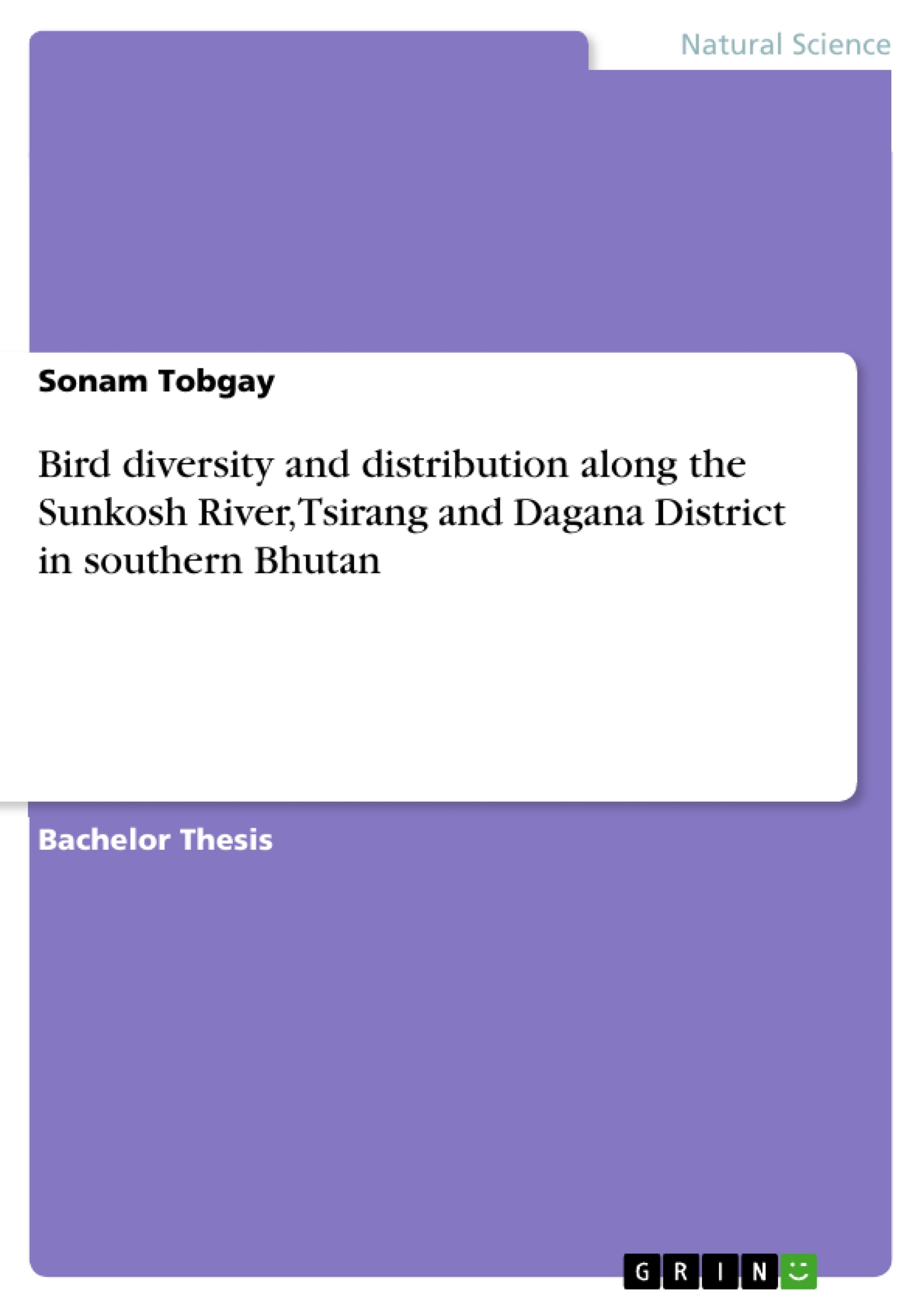The study of bird diversity and distribution along the Sunkosh River, Tsirang and Dagana District, Bhutan was carried out in the winter months to provide comprehensive data on both aquatic and terrestrial birds. This paper focuses on providing some information on the composition, diversity and abundance of various bird species recorded along the Sunkosh River. In order to accomplish this aim, point count survey method was used to generate data for ecological analysis.
A total of 59 bird species belonging to 30 families were recorded during the study. The study was divided into three major habitats: River confluence (Site 1), settlement (Site 2) and undisturbed forest (Site 3). The instruments used were Garmin etrek Global Positioning System (GPS), a pair of binoculars for bird’s identification, a field guide (Birds of Bhutan), survey data sheet and a 300 meters measuring tape. The data were tested with the Kolmogorov-Smirnov method to determine distribution level and bird diversity was assessed using Shannon-Weiner Diversity Index, while parametric tests were applied for all data.
The results showed that bird species diversity was normally distributed in all the sites, site 3 ensured the highest diversity (3.16) compared to site 1: (2.53) and site 2: (3.05). Bird species composition in three habitat types was found statistically significant; correlation result revealed that bird species composition and bird species diversity were negatively correlated with altitude.The most abundant bird species along the River confluence and Settlement area was Red-vented Bulbul, but it was White-crested Laughingthrush in the undisturbed forest.
Inhaltsverzeichnis (Table of Contents)
- ACKNOWLEDGEMENTS
- LIST OF ACRONYMS
- ABSTRACT
- List of Figures
- List of Tables
- CHAPTER ONE
- Introduction
- 1.1 Background
- 1.2 Problem Statement
- 1.3 Research Question
- 1.4 Objectives
- 1.5 Scope and Limitation
- CHAPTER TWO
- Literature Review
- 2.1 Evolutionary History
- 2.2 Ecological Importance of Birds
- 2.3 Diversity
- 2.4 Distribution
- 2.5 Conservation Threat
- CHAPTER THREE
- Materials and Methods
- 3.1 Study Area
- 3.2 Materials
- 3.3 Methods
- 3.4 Data analysis
- CHAPTER FOUR
- Results and Discussion
- 4.1 Bird Species Composition
- 4.2 Bird Species Diversity
- 4.3 Relationship between altitude and BSC, BSD, SE
- 4.4 Relationship between Species composition, species diversity and species evenness
- 4.5 Species Distribution
- 4.6 Bird abundance in the entire study area
- CHAPTER FIVE
- Conclusion and Recommendation
- References
- Annexures
Zielsetzung und Themenschwerpunkte (Objectives and Key Themes)
This study aims to provide comprehensive data on the diversity and distribution of both aquatic and terrestrial birds along the Sunkosh River in Tsirang and Dagana Districts, Bhutan, during the winter months. The study focuses on understanding the composition, diversity, and abundance of various bird species observed within the riverine environment.
- Bird Species Composition
- Bird Species Diversity
- Habitat Use and Bird Distribution
- Relationship between Bird Diversity and Altitude
- Conservation Implications
Zusammenfassung der Kapitel (Chapter Summaries)
- Chapter One: Introduction - This chapter introduces the study's background, highlighting the importance of understanding bird diversity and distribution in the Sunkosh River region. It outlines the problem statement, research question, objectives, and scope and limitations of the study.
- Chapter Two: Literature Review - This chapter reviews existing literature on bird evolution, their ecological importance, diversity, distribution patterns, and conservation threats. It provides a contextual framework for the current research and identifies knowledge gaps.
- Chapter Three: Materials and Methods - This chapter details the study area, the materials used, the methods employed for data collection, and the data analysis techniques used. It describes the point count survey method, the instruments used, and the statistical procedures applied.
- Chapter Four: Results and Discussion - This chapter presents the findings of the study, analyzing bird species composition, diversity, and their relationship to altitude and habitat type. It examines the distribution patterns of bird species across the study area and explores the factors influencing their abundance.
Schlüsselwörter (Keywords)
This study centers on exploring bird diversity, distribution, and habitat use in a riverine ecosystem. Key concepts include bird species composition, species richness, species diversity, species evenness, point count surveys, habitat types, altitude, and conservation implications. The research utilizes statistical analysis techniques like the Shannon-Weiner Diversity Index and Kolmogorov-Smirnov method to understand the patterns of bird distribution and diversity.
- Citation du texte
- Sonam Tobgay (Auteur), 2016, Bird diversity and distribution along the Sunkosh River, Tsirang and Dagana District in southern Bhutan, Munich, GRIN Verlag, https://www.grin.com/document/347025




